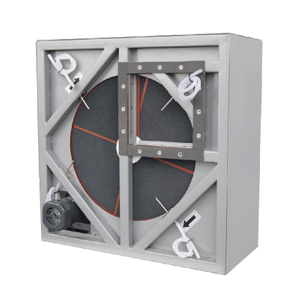What is a Rotor Concentrator System?
Views: 135 Author: Site Editor Publish Time: 2022-01-25 Origin: Site
The rotor wheel is a temperature swing adsorption device designed to continuously remove VOC from a low-concentration, high-volume air stream by adsorbing VOC to a hydrophobic zeolite medium. As a pollution control device, the rotor concentrator is designed to absorb a large amount of air containing very low concentrations of volatile organic compounds (VOC) and adsorb these organic materials onto the zeolite adsorbent material. The rotary concentrator contains a continuously rotating "rotor". This kind of rotor usually has three parts, which respectively play the role of adsorption, desorption, and cooling.
In the entire VOCs adsorption rotor system, a high-quality VOCs adsorption rotor is the most important. As a professional VOCs adsorption rotor manufacturer, the best VOCs adsorption rotor produced by our company is very popular in the market.
The working principle of the rotor concentrator is to use a large volume flow with low volatile organic compound concentration and convert it into a highly concentrated flow. Generally speaking, this work process takes a while. When the rotor rotates, the air containing VOC passes through the adsorption part of the rotor. The exhaust gas stream containing VOC is drawn from the supply piping system and pushed into the rotor housing by the main process fan. When the exhaust gas stream enters the rotor housing, it will slowly pass through the rotor medium, and the VOC molecules contained in the airstream will be collected by the zeolite material. After collecting the VOC, they will be released from the adsorption rotor through the heated low-volume air stream for processing by the thermal oxidizer. The VOC is removed from the process stream and adsorbed onto the zeolite honeycomb medium.
The rotor flywheel is mounted on a shaft with bearings and rotates slowly in the airflow. As the rotary motor rotates continuously, a small amount of cooling air is passed through another part of the rotor for preheating. This air is then mixed with the slipstream from the thermal oxidizer to reach the desorption temperature. The hot air causes the zeolite pore structure to release VOC molecules from the media while concentrating the VOC in the gas stream. The concentrated air stream then leaves the rotor with the VOC and is directed to the thermal oxidizer system for destruction. By concentrating the VOC into a low volume air stream, considerable energy savings, both electrical and gas, can be realized.
In most cases, the VOCs adsorption rotor must have good desorption performance. Generally speaking, the desorption temperature range of a good-quality VOC adsorption rotor is 350 °F to 400 °F. To improve the overall performance of the rotor concentrator, a heat exchanger or a separate desorption heater is usually used in the desorption department.
The advantage of using a rotor concentrator to control VOC is reduced fuel consumption, which is most obvious in the operation of large process waste gas streams with diluted VOC concentration. Puresci has extensive experience in designing solutions using rotor concentrator technology. If you have questions about integrating the rotor concentrator into an existing system, or need a brand new solution, please send an email to info@puresci.com.



